I came back from Ci’Num yesterday. The event, held in Margaux (very very small French town too far away from the shopping spree i had planned to make in Bordeaux), is a collective and open strategic foresight process that aims to create a worldwide community of thinkers and stakeholders, working together in order to identify opportunities and challenges for the future of civilizations confronted with (at least) to main transformations: globalization and digitization.
Nicolas has more on the seminar: CNIUM2006: Facts from today’s seminar and CNIUM2006: surface subways, prabsence and the “whyâ€? question.
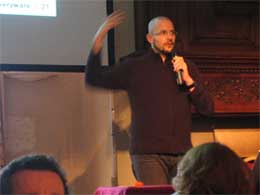 Adam Greenfield gave a brilliant speech on Friday at Ci’Num. Greenfield has written a book i’d recommend everyone to read ASAP (and if you don’t trust my judgement…): Everyware: The Dawning Age of Ubiquitous Computing (on Amazon: USA and UK), it deals with ubiquitous computing and its implications for society, for business, for the way we design spaces and cities – even for the way we relate to each other.
Adam Greenfield gave a brilliant speech on Friday at Ci’Num. Greenfield has written a book i’d recommend everyone to read ASAP (and if you don’t trust my judgement…): Everyware: The Dawning Age of Ubiquitous Computing (on Amazon: USA and UK), it deals with ubiquitous computing and its implications for society, for business, for the way we design spaces and cities – even for the way we relate to each other.
My notes from his talk, Here, There and Everywhere: Issues in Cross-Cultural Ubiquitous Computing.
Circa 1990, Mark Weiser at Xerox PARC coined the term ubiquitous computing or “ubicomp”, he said that information would be invisible, “in the woodwork everywhere around us.”
Characteristics of ubicomp? Embedded, communicates wirelessly, imperceptible, multiple services and devices, post-GUI (Graphical User Interface), information processing dissolving in behaviour.
First example of Ubicomp. In Hong Kong, there’s an RFID touchless payment system called Octopus. First designed for public transport, the system has now pervaded the whole city. It works by tapping a smartcard on a reader. But the range is so good that a new behaviour has emerged: women leave their card in the bottom of their bag, when passing the reader they merely swing their handbag over it, they never break the pace. This complex payment has thus been reduced to a very simple gesture that was discovered through everyday use and has spread organically. We’ll see more of this kind of unforeseen behaviour.
Information processing is showing up in new places. Korean door lock that features 3 types of keys, a mobile phone-activated one, an rfid one and a biometric one.
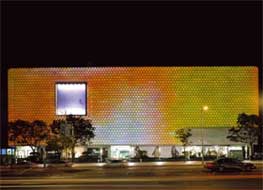
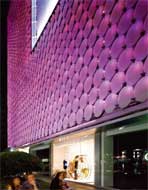
The Galleria department store in Seoul (designed by UNstudio – more images): the lights on its facade respond to the conditions inside the building.
A class of system that tends to colonize everyday life.
Panopticon effect, we redefine the need to feel that we might be observed all the time. Example: the “intelligent rest room” system which integrates into the bathroom monitors your family’s vital statistics (urine sugar levels, blood pressure, body fat percentages and weight). The results can immediately be checked on a screen on the bathroom wall and are uploaded to the family computer where a health care software can advise on diet, exercise, etc.
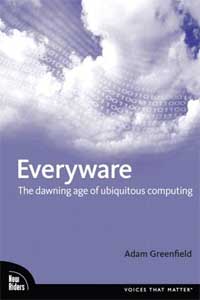 To anyone that says that such examples are sci-fi-esque, Greenfield reminds that:
To anyone that says that such examples are sci-fi-esque, Greenfield reminds that:
The Octopus system has been launched in 1997. By 2004, 95% of the population in Hong Kong aged between 16 and 65 was using this RFID-based system to access private space, pay for a can of Coke or their phone bill. There are more daily transactions than residents in the city.
In New Songdo City, a “ubiquitous city” being built in South Korea, all major information systems share data, and computers are to be built into the houses, streets and office buildings. The project has been launched in 2004 and is backed by ABN Amro, Kookmin Bank and Woori Bank.
Such projects are not just an “Asian affair”. Mastercard PayPass, launched last year in the US, is also RFID-embedded and works in a way very similar to the Octopus card.
Greenfield’s principles of ubiquitous computing:
1. Default to Harmlessness – in a world where it is possible for a device to broadcast your most intimate details, user’s safety (physical, psychic and financial) must be ensured.
2. Be Self-Disclosing – ubiquitous systems should be technically and graphically self-disclosing, so that users encountering them are empowered to make informed decisions. Adam and his wife, Nurri Kim, worked on a few icons (PDF) that could inform the viewer about the type of device they are interacting with and what information about them will be shared.
3. Be Conservative of Face – ubiquitous systems must not unnecessarily embarass, humiliate, or shame their users.
4. Be Conservative of Time – Ubiquitous systems must not introduce undue complications into ordinary operations and should ba respectful of our time.
5. Be Deniable – Ubiquitous systems must offer users the ability to opt out, always and at any point.

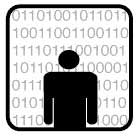

Of course, things gets a little more complicated when one thinks that each community, each culture comes with its own problems. Everyware presents itself as universal and neutral, while our values are different. For example, risk and safety are constructed very differently from society to society.
The US are very concerned by their own safety. Playgrounds would typically be surrounded by fence and carry warnings. That would be insane in German context where it is believed that childhood implies risks and play involves the idea of danger. In Japan (which on several aspects can be regarded as a “nanny state”) escalator chimes in warnings upon approach (“the entrance to the escalator is here, take care upon alighting on the escalator”), upon approach to the top (“the escalator will be slowing down”, then “the escalator is slowing down”), etc.
Similarly the desire to connectedness is constructed differently from society to society: US citizen are unwilling to get any intrusion into their privacy; whereas Koreans and Japanese want to be connected all the time.
Social status is differentially explicit. In the US, the notion of hard-coded markers of society is not accepted, US citizens like to think they live in a class-less society. In Japan and Korea, social status tend to be much stronger: which school you attended matters for example.
Levels of public investment in infrastructure diverge widely (wifi in subway in Japan).
Adam’s point is not to judge but to note these differences.
How do we get to design systems that are robustly ubiquitous and that respond to the differences in people’s experiences?
Old fashioned idea: consciousness-rising; improved methodology foregrounding, ethnography and user insight; a role for standard bodies; regulatory community to protect people’s prerogatives.
More about Greenfield and his latest book, Everyware: The Dawning Age of Ubiquitous Computing: Designing for everyware: An interview with Adam Greenfield, Ethics and RFIDs – video of Adam “Everyware” Greenfield.
